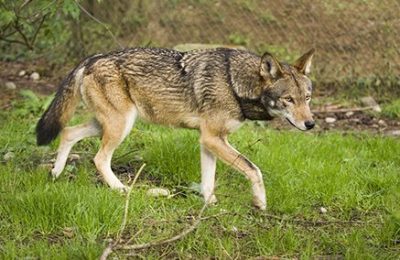WASHINGTON, D.C. — Disparaged by some critics of the red wolf conservation program as “coy-wolves” unworthy of federal species protection, the red wolf now has official scientific backing that it is indeed its own separate wolf species.

A 94-page report, Evaluating the Taxonomic Status of the Mexican Gray Wolf and the Red Wolf, released Thursday by the National Academy of Sciences, Engineering and Medicine finds that the red wolves roaming in northeastern North Carolina, some of the few remaining in the wild, have genetic characteristics that are unique to the historical red wolf.
Supporter Spotlight
“They do share genes with gray wolves and coyotes,” Joseph Travis, chairman of the Committee on Assessing the Taxonomic Status of the Red Wolf and the Mexican gray wolf, said in an interview. “However, red wolves have genes that are found in neither gray wolves nor coyotes. That tells us they are not just hybrids. They really are distinct.”
The study, requested by Congress and sponsored by the U.S. Fish and Wildlife Service, also finds that the Mexican gray wolf is a valid taxonomic sub-species. Based on “the intellectual contributions of a host of scientists,” Travis wrote in the report, the assessments included examination of the fossil record and published research from the last 100 years. The earliest specimen identified as a red wolf goes back 10,000 years.
Historically, red wolves – bigger than coyotes and smaller than gray wolves – ranged over much of the southeastern U.S., but because of overhunting and other pressures, populations declined drastically in the 20th century. After being listed as endangered in 1967, red wolves were declared extinct in the wild in 1980.
The U.S. Fish and Wildlife Service transferred four pairs of captive wolves to Alligator River National Wildlife Refuge in 1987, and eight years later the agency formalized a plan to manage the “nonessential, experimental population” in a five-county recovery area in northeastern North Carolina.
The agency has managed the red wolf as valid taxonomic species under federal Endangered Species Act regulations. But the program’s initial success has been marred by controversy over red wolf range on private property and its genetic identification.
Supporter Spotlight
Proposed management changes that would drastically shrink the red wolves’ range and active management of the animals by Fish and Wildlife Service are currently on hold. The agency did not respond Thursday morning to a request for comment on the academy’s assessment.
“Now that the National Academy of Science experts have deemed the red wolf to be a valid species, it is time for FWS to stop looking for excuses and start revamping and revitalizing their stalled recovery efforts for the red wolf in the wild,” said Ron Sutherland, chief scientist for Wildlands Network, a nonprofit environment group that has advocated for red wolf conservation. “With only about 25 free-ranging red wolves left in eastern North Carolina, the species only has a few years to go before it succumbs to extinction in the wild for a second and possibly final time.”
Derb Carter, senior attorney and director of the Southern Environmental Law Center’s North Carolina offices, said the report confirms the longstanding classification of red wolves as a distinct species deserving of protection, underscoring the urgency for the Fish and Wildlife Service to act to save the wild red wolf.
“A federal court found in November that the agency violated the Endangered Species Act when it ended proven conservation measures like coyote sterilization and releases of captive red wolves and failed to respond to the ongoing decline of the species. Now, USFWS has stated that there is only one known breeding pair of red wolves left in the wild. Time is running out to do what we know is required to save this species,” Carter said.
Scientists have also confirmed, Travis said, that a population of wild wolves that live on Galveston Island in Texas share the same historical red wolf genes as the North Carolina wild red wolves.
The National Academy describes itself in a media release as private, nonprofit institutions that provide independent analysis in the interest of solving complex problems and to inform public policy decisions.








